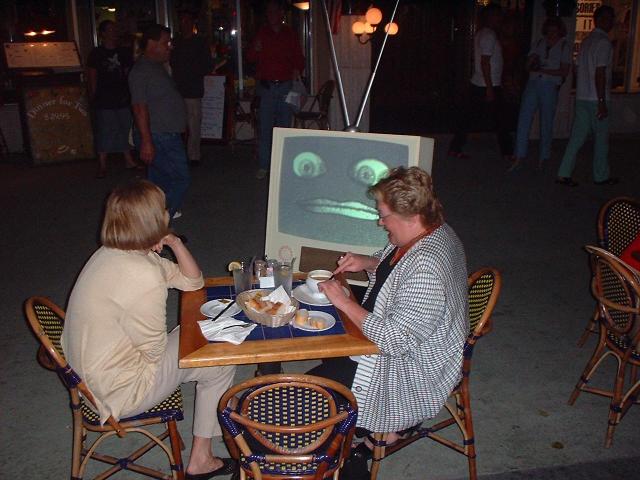
Florida/Brazil Festival
2001
November 3, 9 and 10, 2001
Lincoln Road, Miami Beach
The publicity for this video sculpture reads, “Love it, trash it, we can't keep our eyes off it. Friend or foe, salvation, or just an indication of our collective demise--who cares? Just keep watching.” Video art is filled with television sets, whether in the mangled form of Nam June Paik's sculptures built from the sets, the dismembered tubes of Gary Hill, or the ascetic arrays of Frank Gillette, television is the perennial subject of much of video art. And it comes as no surprise, really--television, “TV,” is as common a household appliance as a toaster or refrigerator and the power and role it plays in our lives has been a topic of debate almost since it started broadcasting over fifty years ago.
The art world has always had a love/hate relationship with television. Perhaps this is because it is a medium which has enormous power and promise, yet so seldom delivers on what it offers. This problematic aspect of TV is the focus of a new video sculpture by artist Charles Recher commissioned by Tigertail productions for the Florida/Brazil Festival. The vision of TV embodied in this work is both historical and weirdly familiar: the sculpture itself is a giant set more familiar now from old TV shows and thrift stores--its silver rabbit ears pointing skyward like a Martian's antennae, the dials on the front reminding us of an age before color, remote controls and cableTV. Physically this is the archetypal TV from our culture's collective (and fading) childhood.
On screen, however, is a different story. Instead of showing us reruns of I Love Lucy or Gunsmoke, this TV feels the need to speak out: it has a pair of beady eyes a little too close together and a mouth which smiles a little too widely, not so much a face as a TV version of the circular yellow smiley-face we all know and hate. It talks with a woman's voice, yelling at us to “Stop Looking” or “Don't Go, Don't Go” and, inevitably, “Get Out Of The Way” as it moves down Lincoln road, apparently master of its own destiny. It is the dynamic created by the interaction between TV and its audience which makes this piece different from the stationary dolls of Tony Oursler, (a dynamic that also evades capture in a critical article like this one).
The kind of things it has to say are significant, implying a darker purpose beneath the humorous façade: central to its routines (which seem to vary rather than running in a loop) is a short, happy, children's nonsense song:
And the rasp and the little rock
And the so on so on so on
And the rasp and the little rock
And the so on so on babe.
But is this song nonsense? The other things this set has to say passing its comments about the audience not thinking off as jokes, suggests that this routine is central to the piece. The remainder of the set's monologue--directed at anybody it happens to approach--talks about how much time we spend with our TVs, how it “loves us” and wants to give us what we want punctuated by pleading and threatening repeats of “Stop Looking” suggests that this set is telling us something crucial through this song. The lyrics are menacing. A “so on, so on” is not a positive description, it is something that used to be applied to trouble makers, and when a rasp is working a board and hits a little rock, instead of continuing to plane the board smoothly, it stops and cuts a groove in the work because the little rock is a point of resistance. Within the context of TV, the rasp is the TV and the little rock is the audience member who becomes aware of what's happening, of how TV is manipulating them. This is the way the content of TV differs from Richard Serra's Television Delivers People--a silently scrolling text talking about how the audience is the product of television--because the meaning of the piece is embedded in the performance, it is only when we stop and think about it that we realize what's happening, as is the case with regular TV programming.
This casts the humor of TV in a different light entirely: it is the laughing off of the monstrous, the nervous laughter that hides an experience of terror as Sigmund Freud suggests. This TV with its beady eyes and over-wide smiling mouth floating above a mixture of static and flashes of faces, bits of shows and the ever-present flicker of switching channels suggests that what we have wandering Lincoln road and sitting in most of our houses is not our friend, but a demonic presence which tells us the truth even though we're not listening. “You see, I want your attention”… and as the press release reminds us of our usual views of TV: “Who cares?--Just keep watching.”
And we do.
